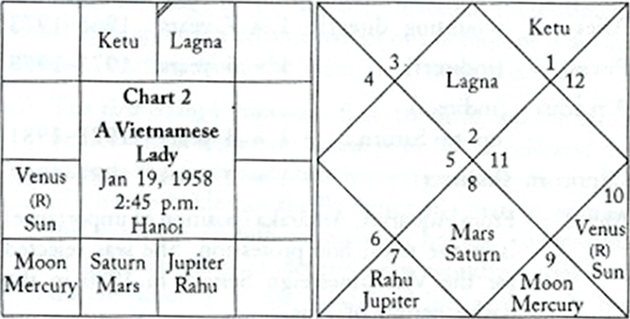Pancha Mahapurusha Yogas
Now effects of Malavya and other Yogas caused by the five non-luminary planets as per Saravali.
548 – 549. Malavya Yoga: The native of Malavya Maha Purusha Yoga will have thin lips (not being fleshy) and will have an even physique. He will not have any extra limbs, will have a slender waist, and will possess the splendour equal to that of the moon. His voice will be akin to that of an elephant. He will have prominent cheeks, shining eyes, even and white teeth, long arms touching the knees and will be a king. He will live upto 70 years of his life. His face will be 13 inches (ancient measurement) and be 10″ long from the ear-whole. He will rule over Laata, Mala, Sindhu and Pariyatra regions.
550 – 552. Ruchaka Yoga: The native having Ruchaka Yoga will have a long face, be endowed with radiance and plenty of blood, will achieve his undertakings through his valour, will have beautiful eye-brows and dark hair, be industrious in nature, will have knowledge of machinery, be the head of thieves, of dark ¬red complexion, be very heroic, will destroy his enemies, will have a neck resembling a conch, be a chief person, be evil, devoted to others, obedient to Brahmins and elders, and will have thin arms and knees. There will be special marks on his palms and soles of bed, rope; ox, arch, wheel, lute etc. He will be hundred¬ inches tall, be skilful in Mantras even among a thousand people and be happy for a long time. He will enjoy happiness for seventy years in the cities held betwixt the regions of Vindhya and Sahya mountains. His death will be through fire or weapons;
553 – 555. Sasa Yoga: One born in Sasa Yoga will have small teeth and walk in a fast pace. He will be crafty, very valorous, interested in wandering in forests, mountains, forts etc, will have a depressed belly, be not very short, be the head of an army, interested in oceans, skilful in metals, fickle-minded, will have eyes resembling that of a swine, charming knees, and thin waist, be endowed with spouse, will enjoy others’ wealth, be devoted to his mother, will have various kinds of dispositions, will speak will of others and will have marks of bed conch, arrow, drum, garland, lute etc. on his palms and soles. He will be a king of some region for seventy years, so have said the sages.
556 – 558. Bamsa Yoga: The native of Hamsa Yoga will have reddish and elevated (or prominent) nose and beautiful legs. He will be-endowed with great virility and be fair in complexion. His cheeks will be fleshy and nails reddish. He will possess a voice comparable to that of a swan. He will be phlegmatic and will have marks of conch, lotus, arch, sword, garland, and pot on his palms and soles. His eyes will reflect the colour of honey and his head will be round in shape (i.e. well-formed). He will be fond of moving in places of water resorts and will not be satisfied in his sexual union with females. He will be very libidinous. His weight will be 1600 (units of ancient measurement) and he will be 16 inches tall (again ancient measurement). He will rule Soorasena, Gandhara, and the regions between Ganga-Yamuna rivers. He will live for a hundred years and will die m forests.
559 – 563. Bhadra Yoga: One born in Bhadra Yoga will have a face resembling that of a tiger. His gait will resemble an elephant’s gait. His knees and chest will be stout. He will possess long and stout, arms, and soft hair. His arms and legs will be like the stem of a lotus. He will be a scholar. He will have knowledge of Yoga (physical exercises). There will be marks of conch, sword, mace, lute, flag, wheel, lotus, plough etc. in his palms and soles.
His bodily fragrance will be comparable to that of the ichor of elephant, and the initial rains of the season. He will have a charming nose, will have knowledge of meanings of the Saastras, be courageous, poisonous in disposition, will have a notable belly, be firm in disposition, will have black and curly hair and will not forgive his men. His wealth will be consumed by ministers and others. His weight will be one Bhaara and he will rule over the region of Kanya Kubja. He will live upto 80 endowed with spouse and others.


